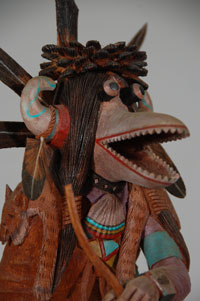Hopi Cottonwood Root White Ogre (Wiharu) Katsina Doll [SOLD]
+ Add to my watchlist Forward to Friend
- Category: Contemporary
- Origin: Hopi Pueblo, Hopituh Shi-nu-mu
- Medium: cottonwood root, stains
- Size: 13-3/4” tall to tip of head; 16-1/4” to tip of feather
- Item # C3318B SOLD
 A function of the Ogre Katsinas is to act as disciplinarians for the Hopi children. One of their responsibilities is to appear at the home of a Hopi and demand to see the children that they then question as to their behavior and whether they have learned the chores they are supposed to know—for the girls that could be the proper way to grind corn on a metate with a mano and for the boys the proper way to hunt rabbits. If there are questions by the Ogres as to whether the children have learned their lessons, they may give them a week or two to practice and let them know that they will be back again to check on progress. Of course, the children are terrified of the anticipated return of the Ogres.
A function of the Ogre Katsinas is to act as disciplinarians for the Hopi children. One of their responsibilities is to appear at the home of a Hopi and demand to see the children that they then question as to their behavior and whether they have learned the chores they are supposed to know—for the girls that could be the proper way to grind corn on a metate with a mano and for the boys the proper way to hunt rabbits. If there are questions by the Ogres as to whether the children have learned their lessons, they may give them a week or two to practice and let them know that they will be back again to check on progress. Of course, the children are terrified of the anticipated return of the Ogres.
When the Ogres do return, it is in preparation for a Katsina dance, and they are actually in pursuit of food to take to the kivas for the dancers. To do this, they demand to see the kids and threaten to take them away, but the mother of the house bargains with the Ogres and offers food instead of the children, which buys off the Ogres and greatly impresses the children about their mothers.

The White Ogre (Wiharu) and the Black Ogre (Nataska) are identical except in color. Their functions are the same. They always appear in pairs and accompany the Soyoko on their collection trip and usually stand directly behind the one who is bargaining with the relatives of the children. They make horrible noises, dragging their saws along the side of the house or on the ground. They also keep up a steady stamping that makes the shells on their legs sound ominously. From an early age, the children have learned that the Ogres can eat a child whole and will do so. No wonder they are so terrified of them.
This carving was completed by Hopi artist Sam Kayquoptewa in 1991 at which time Adobe Gallery purchased it and sold it to a client in New York. Now it is back for us to sell again. It is basically a one-piece carving from bottom to top with certain items obviously added separately. The obvious add-ons are the bow in the left hand, the bug eyes and the feathers on and around the head. It appears that everything else is from the same piece of wood.
It is almost inconceivable that a carver could visually anticipate everything he was going to carve and be able to do so as he worked through the piece of cottonwood root. There are numerous items that had to be planned in advance such as the shell necklace, fox skin on the shoulders, hair draping from the face, the very long snout, a quiver on the back and many other details.
Looking at this carving, it becomes obvious why Kayquoptewa was selected for the Award of Excellence in Katsina Doll Carving in 2003 and again in 2004 at the Southwest Indian Art Fair sponsored by the Arizona State Museum, an award judged by Delbridge Honanie, also a top prizewinning carver.
Condition: original condition:
Provenance: from the collection of a New York client
Recommended Reading: Hopi Katsina 1600 Artist Biographies by Gregory Schaaf
- Category: Contemporary
- Origin: Hopi Pueblo, Hopituh Shi-nu-mu
- Medium: cottonwood root, stains
- Size: 13-3/4” tall to tip of head; 16-1/4” to tip of feather
- Item # C3318B SOLD



